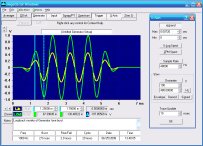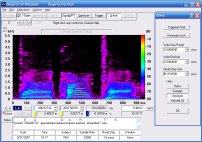![[LogoShip]](logo5.png)
Software for Windows
Science with your Sound Card!


Features:
Oscilloscope
Spectrum Analyzer
8-Channel
Signal Generator
(Absolutely FREE!)
Spectrogram
Pitch Tracker
Pitch-to-MIDI
DaqMusiq Generator
(Free Music... Forever!)
Engine Simulator
LCR Meter
Remote Operation
DC Measurements
True RMS Voltmeter
Sound Level Meter
Frequency Counter
Period
Event
Spectral Event
Temperature
Pressure
MHz Frequencies
Data Logger
Waveform Averager
Histogram
Post-Stimulus Time
Histogram (PSTH)
THD Meter
IMD Meter
Precision Phase Meter
Pulse Meter
Macro System
Multi-Trace Arrays
Trigger Controls
Auto-Calibration
Spectral Peak Track
Spectrum Limit Testing
Direct-to-Disk Recording
Accessibility
Data Logger
Waveform Averager
Histogram
Post-Stimulus Time
Histogram (PSTH)
THD Meter
IMD Meter
Precision Phase Meter
Pulse Meter
Macro System
Multi-Trace Arrays
Trigger Controls
Auto-Calibration
Spectral Peak Track
Spectrum Limit Testing
Direct-to-Disk Recording
Accessibility
Applications:
Frequency response
Distortion measurement
Speech and music
Microphone calibration
Loudspeaker test
Auditory phenomena
Musical instrument tuning
Animal sound
Evoked potentials
Rotating machinery
Automotive
Product test
Contact us about
your application!
Macro Read-Only Variables
Normal Macro Variables and main Daqarta control variables like TrigLevel and ToneFreq can be both read and written, meaning they can appear on either side of a macro expression.
Read-only variables can only be read. (Attempts to set them are ignored.) Generally, that means you can only use them like normal or string variables on the right side of an expression, as in A=DeltY or Msg=Freq.
However, you can also use them on the left side of an IF test, as in IF.Frames=>100.
Similarly, you can use them on the left side of a WHILE statement, as in WHILE.Volts=<1.000.
The following is a list of read-only variables:
CursY, CursY?, CursDotY, CursDotY?, UnitX, UnitY
DeltX, DeltY
WinVer
Frames
Freq, Total
SPL
Volts
GenMode
SyncMode
DiskSpace
Timer
Time
FileName, FileName?
FileInfo?B, FileInfo?F, FileInfo?T - file format
FileInfo?C, FileInfo?M - file channels
FileInfo?S - file total samples
RangeDlg?, GainDlg?
Atten_dB?, Atten_G?
Range?
UserFactor?, UserSPL?
FcountDlg?, SPLdlg?, VoltDlg?, MacroDlg?
Ch?
ColorNum?
Key?
Posn?
Buf0? to Buf7?
Mtr0?, Mtr1?, Mtr2?, Mtr3?
Ctrls?, Ctrl0?, Ctrl1?, Ctrl2?, Ctrl3?
MIDIrec?
The variables ending in '?' require a single query character immediately following, which specifies one of a subset of possible values to be read. For example, Posn?X holds the current X position of the mouse cursor, while Posn?Y holds the Y position. Note that some of these query-type variables (CursY, CursDotY, RangeDlg, GainDlg, UserFactor, UserSPL, FcountDlg, SPLdlg, VoltDlg, MacroDlg, Ch, Mtr0-3, and Ctrl0-3) are also used as ordinary controls without the '?'.
Read-only variables can be used in String Expressions for such things as Notes, Custom Meters, message text (WaitMsg and Msg), and Log File macros. Note, however, that DeltX, Freq, Volts, and SPL have a default format that is the same as that used for the normal Daqarta display.
For example, if the Voltmeter reads "123.456 mV" then Msg=Volts will display that string exactly. But if you use any of the numeric formatting options discussed in String Variables and Expressions, that takes priority. Only numeric data is shown, and the "mV" is rolled into the value. Msg=Volts(0.5) would thus show "0.12345".
Similarly, if Spectrum Cusor Ratio is active and the Delta Readout shows "R: 1.23456", then Msg=DeltX will show exactly that, while Msg=DeltX(0.2) will show "1.23" without any "R:" prefix.
See also Macro Overview
- Back to Macro Variables
- Ahead to Macro Arrays Buf0-Buf7, BufV
- Daqarta Help Contents
- Daqarta Help Index
- Daqarta Downloads
- Daqarta Home Page
- Purchase Daqarta
Questions? Comments? Contact us!
We respond to ALL inquiries, typically within 24 hrs.INTERSTELLAR RESEARCH:
Over 35 Years of Innovative Instrumentation
© Copyright 2007 - 2023 by Interstellar Research
All rights reserved